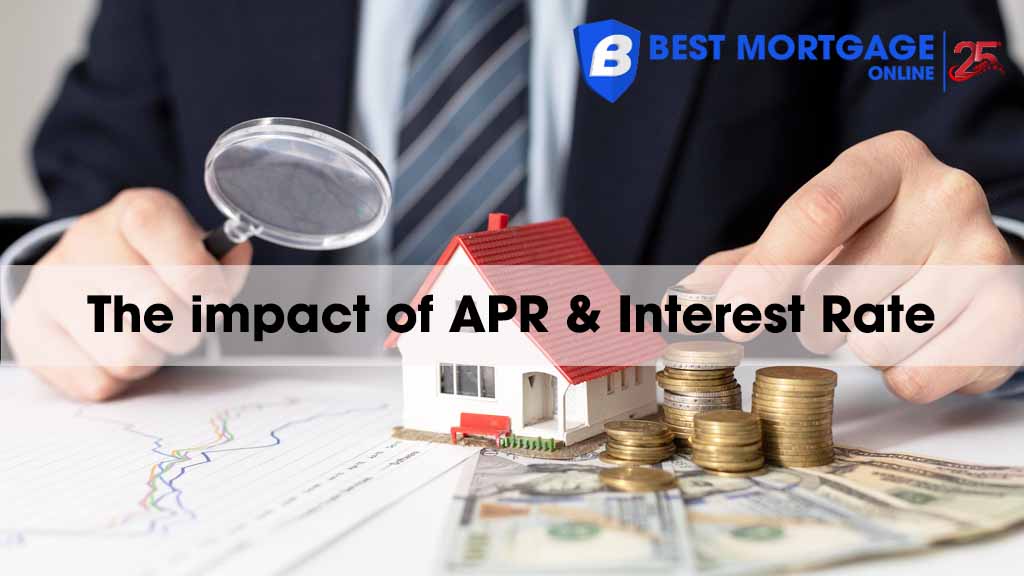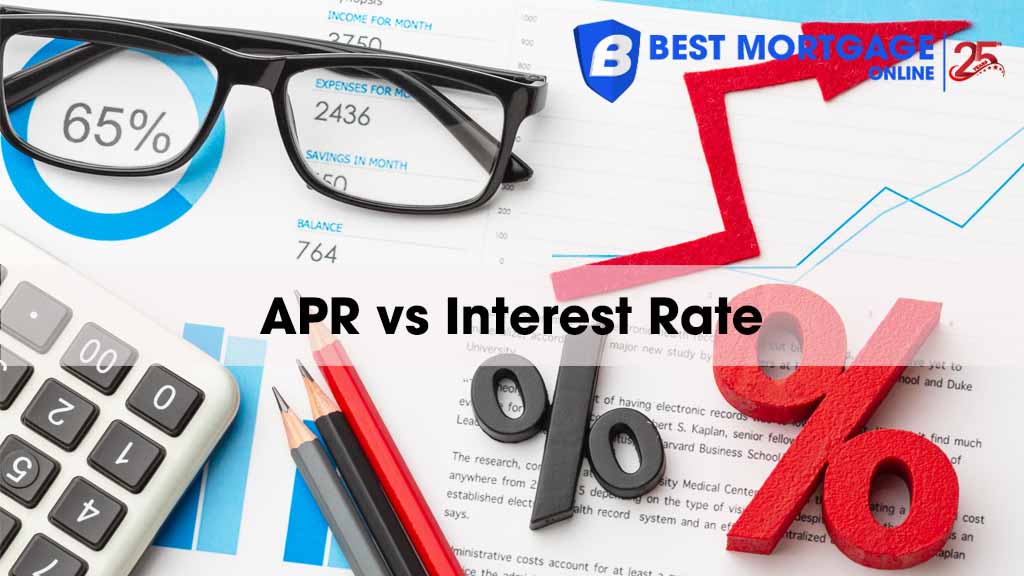Misunderstanding the concepts of APR vs Interest rate in Canada can lead to costly decisions. Understanding both metrics reveals the complete picture of borrowing costs beyond advertised rates. This guide clarifies these critical differences to help Canadians make informed choices when comparing mortgages, car loans, and credit products. Find out all about the topic by reading this BestMO’s article.
What is the difference between interest rate and APR?
The core difference between annual percentage rate (APR) and interest rate is that interest rate only reflects the cost of borrowing the principal amount. At the same time, the APR includes both the interest rate and all additional fees associated with obtaining the loan.
A borrower comparing two mortgages would look at:
| Factor | Interest Rate | Annual Percentage rate |
|---|---|---|
| What it includes | Base cost borrowing only | Interest rate + all fees |
| Best used for | Calculating monthly payments | Comparing total loan costs |
| Impact on decision-making | Partial cost picture | Complete cost picture |
| Calculation complexity | Simple percentage | Complex calculation including fees |
Besides, interest rates affect you immediately through monthly payments, while APRs’ impact depends on how long you maintain the loan. This difference means your best option depends on how long you plan to keep the loan. For example, if you pay extra fees upfront to get a lower interest rate but sell your home after just 3 years, you may not save enough on interest to make up for those costs. On the other hand, if you plan to own the home for 15 years or more, it’s better to focus on the APR because it gives a clearer picture of the total cost over time.
While having distinct definitions and applications, APRs and interest rates have many common features. They are key factors that directly impact how much a borrower will pay on a loan or line of credit. Additionally, depending on the loan product, both rates can be fixed or variable. Also, in revolving credit, the APR and interest rate are often the same.

Impact of APR and interest rate on mortgage
Both APR and interest rates significantly impact your mortgage, but in distinctly different ways. When deciding between mortgage offers, looking at interest rate vs APR rates helps identify the true cost differences. There are 3 points that affect your mortgage:
Monthly payment
For a mortgage of $500,000 with a 25-year mortgage amortization:
- At 4.5% interest: Monthly payment approximately $2,779
- At 5.0% interest: Monthly payment approximately $2,908
- At 5.5% interest: Monthly payment approximately $3,040
As you can see, the $261 monthly difference between 4.5% and 5.5% translates to $78,300 in additional payments over the mortgage’s lifetime. It is the reason why even small interest rate differences matter substantially.
Total cost
Canadian mortgage borrowers often encounter the payment categories that affect APR:
- Fees: Lender fees include origination charges, application fees, and appraisal costs. Legal fees for title searches and documents add another cost.
- Insurances: For high-ratio mortgages where your down payment is less than 20%, CMHC mortgage insurance premiums can add 2.8% to 4% of your mortgage amount.
- Another factor, such as the mortgage stress test, uses a qualifying rate that does not directly affect your APR. However, it influences which mortgages you can qualify for. That can push you toward options with different fee structures.
Strategic decision-making
If you plan to remain in your home for the full amortization period, APR provides the most accurate cost comparison. However, if you anticipate selling or refinancing your mortgage within a few years, the interest rate might be more relevant because you will not amortize upfront fees over the full term.
Let’s consider:
Mortgage Option A offers 4.25% interest with $8,000 in total fees. Mortgage Option B provides 4.40% interest with $2,000 in fees. For a $400,000 mortgage:
- Option A: APR approximately 4.38%
- Option B: APR approximately 4.43%
Despite Option B’s higher interest rate, its lower fees make it more attractive for borrowers planning to sell or refinance within five years because they will pay less in upfront costs, while the interest rate difference has minimal impact over the shorter timeframe.
Why is understanding Interest rate vs APR important?
The implications of APR vs interest rate become evident in real lending scenarios. For example, a mortgage with a lower interest rate and high closing costs might be more expensive than one with a higher rate and minimal fees. Relying only on interest rates could obscure lender fees folded into the APR. Knowing the APR prevents surprise charges.
In addition, local regulations can affect how is APR calculated. The same loan might have different APRs depending on where it is offered.
Understanding the differences between interest rates and APRs helps consumers to forecast costs, avoid hidden fees, assess variability, and select the most suitable products.
Let’s look at their definition one more time to have a better idea of the APR vs interest rate on a mortgage.
What is an interest rate?
An interest rate is the cost borrowing money, expressed as a percentage rate. It represents the amount of interest a lender will charge for the use of their money over a period of time.
There are 2 types of interest rates:
- Fixed rate: remains stable over the full loan term.
- Variable rate: fluctuates based on economic factors like the Bank of Canada rate, government bond yields, competition, etc.
When applying for a mortgage, lenders assess your credit score, income, debts, and down payment. Your interest rate will be lower with these 3 points:
- Higher credit scores and lower debt-to-income ratios
- Larger down payments
- Shorter mortgage terms
What is APR?
The Annual Percentage Rate is the total yearly cost of borrowing. It includes the interest rate plus expenses charged by the lender and any additional fees (discount points, loan origination fees, closing costs, insurance, etc.). It is shaped by:
- Government monetary policy
- Competitive lending markets
- Perceived default risk
You can learn more about how APR is calculated to understand this terminology better.
FAQs about Interest Rate vs APR in Canada
Which is better, APR or interest rate?
Neither APR nor interest rate is better. They serve different purposes in evaluating loan costs. APR is better for comparing the total cost of different loan offers. The interest rate is better for understanding and calculating your monthly payment.
Why is my APR higher than my interest rate?
Your APR is higher than your interest rate because APR includes all the additional costs associated with obtaining your loan beyond just the interest charges.
Does APR include the interest rate?
Yes, APR always includes the interest rate as its foundational component, plus additional loan-related fees and costs.
Do I pay APR if I pay on time?
You do not directly pay APR as a separate charge; rather, APR represents the total cost of your loan expressed as an annual percentage, which you pay through your regular payments and upfront fees regardless of payment timing.
The Bottom Line
While related, APR and interest rate are distinct metrics that together reveal the true cost of borrowing for major financial products. The interest rate tells you how much you will pay just to borrow money, while the APR includes that interest plus any extra fees. Whether you are applying for a mortgage, car loan, or any other type of loan, comparing both numbers gives you a clearer view and helps you choose the option that saves you the most money.



